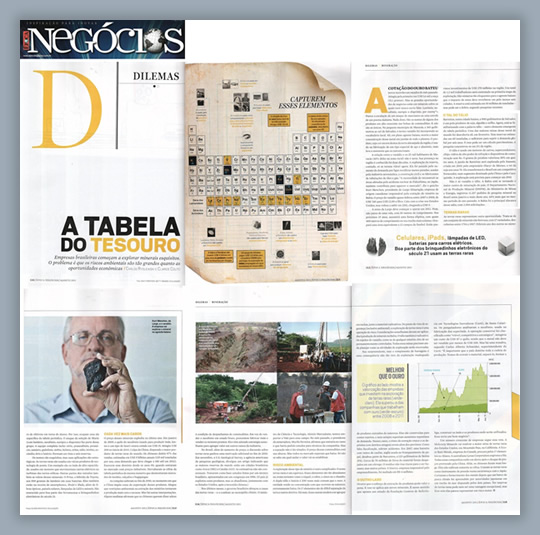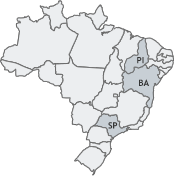
The treasure table
Brazilian companies have begun exploring strange minerals. The problem is that environmental risks are as large business opportunities
The price of gold reached new records in the middle of last month. The ounce (31.1 grams) rose for the first time to US$ 1.6 thousand. But great business opportunities reside in minerals of which you have never heard. Lanthanum, neodymium, europium, and dysprosium, for example. This seems like a Martian front-line of attackers or a strophe from a Dadaist poem. Not at all. They are names of a few of the up-and-coming goods found in the commodities market. And that is not all. In the small municipality of Maracás, 365 km south of Salvador, the word vanadium has been adopted by the local vocabulary. Right there in the middle of the state of Bahia’s backlands, may be found the planet’s largest concentration of this metal in orebodies. This element, of a dark color that contrasts with the orange-like color of the region's land, is employed to produce a special type of steel and aluminum, lighter and more resistant than conventional alloys.
The relation between vanadium and the 25 thousand inhabitants of Maracás (40% of them in the rural region) is not new. Its existence in then region has been known for two decades. Nonetheless, exploring this reserve has become feasible only recently. It was encouraged by the rising demand for lighter metallic alloys employed in the aeronautical industry, in civil construction, and by manufacturers of oil and gas pipelines. “The need to rebuild the areas affected by the nuclear accident in Fukushima in Japan also aided in heating the market,” stated chairman Kurt Menchen of Largo Mineração, a Canadian-based company in charge of mining this ore in Bahia. Vanadium prices almost doubled between 2007 and 2008, rising from US$ 7.40 to US$ 12.90 per pound. They dropped with the crisis in the United States but rose again to US$ 9 in 2011.
Largo’s mine should start operating in 2012. It currently is nothing more than a 30-meter long ditch. In the next 15 years it will be elliptical and almost 400 meters long in its longest stretch. It will cover an area equal to 12 soccer fields. Investments of US$ 270 million are estimated for the region. A total of 1200 workers will be hired in the first production stage. These are numbers so eloquent for Bahia’s backlands that the mine’s impact should reflect on at least seven cities. The reserve is estimated at no less than 10 million tons – but this could be doubled, according to recent prospecting. And the thallium in Barreiras, another town in Bahia 900 km from Salvador, is found in a soy, cotton, and corn producing region. It is now getting familiar with the word thallium – another element in the periodic table. One of the world’s largest mines for this metal was discovered there in February. Its reserves are estimated at 60 tons, sufficient to meet world demand for six years. And this could be a conservative estimate. Prospecting was concentrated on 2% of the region.
Thallium is employed in car engines, superconductors, chips, high refraction glass, and wireless communications devices. A gram of this commodity rose 30% in value in four years. The Barreiras orebody will be exploited by Itaoeste, organized in 2002 by businessman Olacyr de Moraes, the soybean king of the 1970s. The company will convert Brazil into a competitive supplier in an activity dominated by China and Kazakhstan. Production is planned to begin in 2015.
This is not only about vanadium and thallium. Bahia is becoming the country’s largest mining center. The Ministry of Mines and Energy’s Departamento Nacional de Produção Mineral (DNPM), has recorded 11,257 applications for mineral prospecting from January to May of this year, 44% in excess of the same period last year. Bahia was the key component in this great leap with 2584 applications. Rare earths
Rare earths have turned into another opportunity. These are a range of 17 varieties of non-ferrous minerals discovered between 1794 and 1907. They are different from each other in the number of electrons that rotate around the atom. For this reason they have a specific place in the periodic table. The Martian front-line of attackers is a part of this group (with lanthanum, neodymium, europium, and dysprosium). The complete team includes praseodymium, promecium, samarium, gadolinium, terbium, holmium, erbium, thulium, iterbium, scandium, yttrium, and lutetium. They form a team and six reserves.
The names are strange but their applications are strategic. Rare earths are employed in a number of goods with state-of-the-art technology. An example is heavy-duty magnets used in motors that power electric cars and turbines in windmill towers. Other vehicle parts also use these minerals. The Prius, Toyota’s hybrid car, uses 500 grams of lanthanum in its batteries. They are also found in smartphones, iPods, and iPads, in addition to optic fibers, solar panels, LED lamps, and missiles. They are essential for a good portion of 21st century tools and electronic toys.
Link: http://epocanegocios.globo.com/Revista/Common/0,,EMI254247-16642,00-A+TABELA+DO+TESOURO.html

Rua Fidêncio Ramos, 160 – 2º andar – sala 211 – CEP: 04551-010 - Vila Olímpia – São Paulo - SP
Tel: (11) 3168-3705 | contato@itaoeste.com.br


